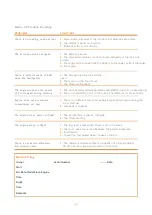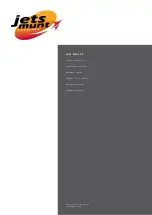
The fuel pump and ECU can be mounted simply with a pair of tie wraps and/or Velcro. The best orientation for
the fuel pump is vertical. It is important to ensure any fuel seepage does not reach the motor brushes. The fuel
feed from the pump to the engine should have sufficient length of the clear tubing fitted to allow the fitment of
the electronic fuel shutoff valve and the valve should always go on the pressure side.
When making any fuel line cuts use a sharp blade to make and cut squarely. The fuel filter provided should
be installed in an accessible place for regular inspection, in line between the tank and the pump.
Fuel and Oil
1.
Use
CLEAN
well filtered Jet A1 or kerosene fuel which is available from most airports, or paraffin (K1) used for
greenhouses available from most hardware stores.
2.
Ensure the fuel is clean and filtered at each stage of mixing and transfer to the model fuel tank.
Please note the importance of using clean fuel. Failure to do so will result in blocka ge s of the fine fuel
injectors in the engine or blocka ge of the engine lubrication system and subsequent bearing damage.
3.
Ensure the fuel is free from moisture (water is heavier than fuel and will settle at the bottom of the
container).
4.
Use good quality aircraft turbine oils e.g. Aeroshell 500, Exxon 2380, Mobil JetOil II, Mobil DTE Light turbine oil
or 2T synthetic oil with a specification JASO FC or better.
5.
The fuel must be mixed with turbo oil in the ratio of 4% oil to 96% fuel (ratio 1:24). Too little oil will shorten the
bearings life. You can use higher content of oil (5-6%) without any problem for the engine to share the same
fuel with other engines.
Please remember to always handle fuel and oils with care! Avoid all direct contact with skin – in case
of contact wash all affected areas with soap and warm water immediately.
Feed Pipes
All the pipes must be Polyurethane or nylon as provided by Jets Munt or Tygon (like the ones used by gasoline
engines). Do not use Tygon on the pressure side of the fuel pump.
Silicone tubing must not be used anywhere in the installation as it is dissolved by fuel and oil. If in doubt, take
a small piece of tube and submerge it in kerosene for a few days and verify that it’s characteristics have not
changed.
16
Maintenance
1.
Always keep the engine and its accessories clean and dry.
2.
Regularly check wires for chafing or insulation breakdown, etc.
3.
Regularly check fuel and gas pipelines for chafing and /or leaks at joints.
4.
Check the temperature probe is correctly positioned.
5.
Check the engine and mounting for loose fittings and secure if required.
6.
Ensure the fuel system is kept free from dust and dirt inclusion and that fuel is carefully filtered.




































